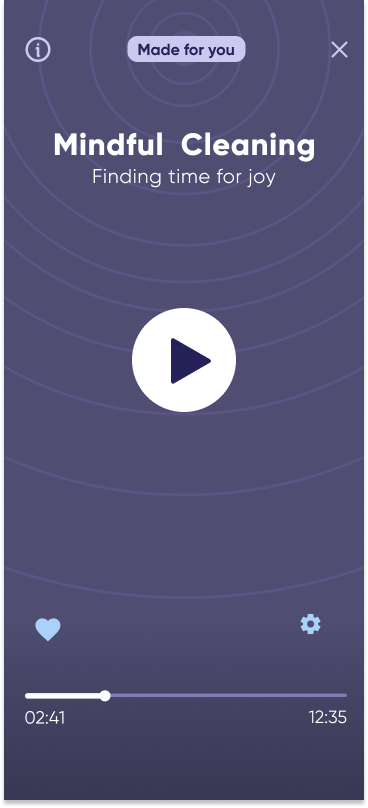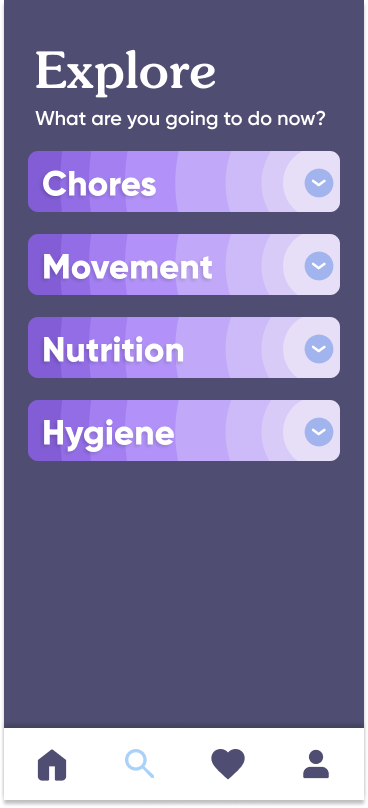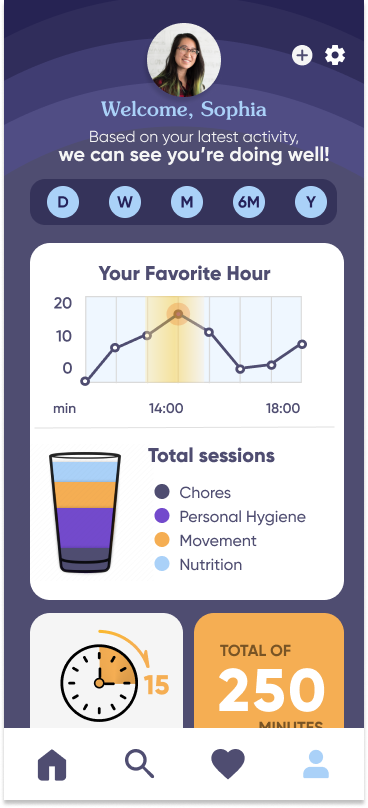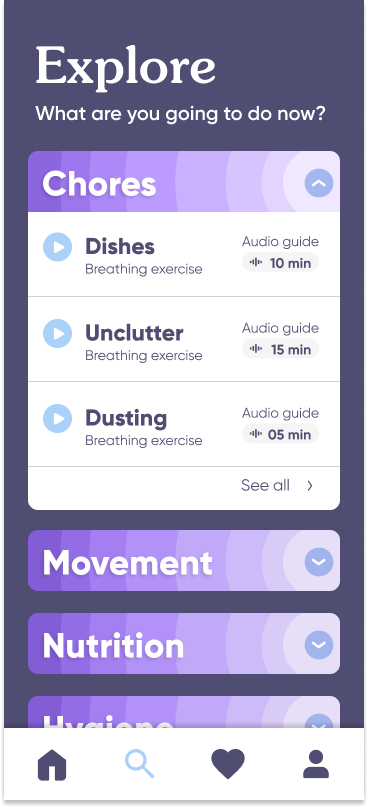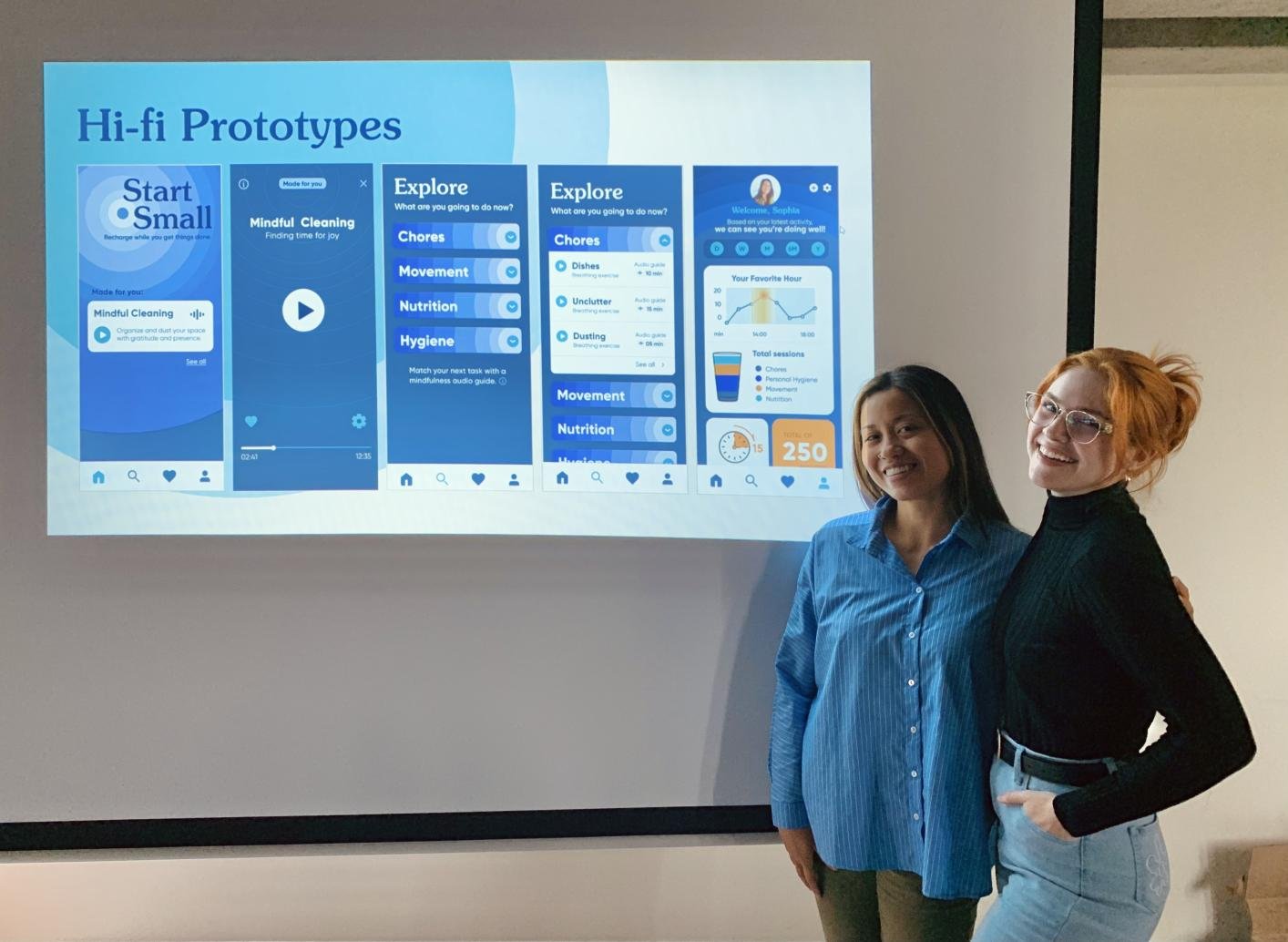PEBBLE MINDFULNESS App
DASHBOARD design
pEBBL, MINDFULNESS APP DASHBOARD DESIGN
Our first cross-departmental collaboration at IronHack Germany involved working with the Data Analytics students on visualizing and organizing data from a study on the quality of sleep. We were inspired by the topic and decided to explore how sleep affects one’s perceived sense of well-being.
We were given a timeline of two weeks to create an MVP to track the user’s personal data on a dashboard page in a mobile application. My partner, Alice and I decided to create an app called ‘Pebble,’ a platform providing mindful activities throughout the day to promote and encourage better sleep at night for the user. Pebble includes an intuitive activity tracker to show patterns and insights of how the user can enhance their mindfulness on a daily basis to create lasting habits and lifestyle changes.
SECONDARY RESEARCH
There are many physiological benefits of sleep including effect on memory, concentration, stress levels, libido, physical health, and longevity. Building a better relationship with sleep and investing in sleep hygiene are common themes among adults who are frequently attached to their phones all day until the moment they fall asleep.
We were interested in exploring the concept, “Revenge Bedtime Procrastination,” which describes the decision to delay falling asleep to explore more leisure time right before bed. This particular behavior is driven by a daily schedule that is busy and lacking in free time after a long day. This can include playing games, scrolling on social media, and watching shows late into the night, further delaying one’s natural ability to fall asleep. Sleep deprivation results as a lack of quality sleep is attained and can cause significant negative effects on one’s mental, physical and emotional health. (“What Is “Revenge Bedtime Procrastination”?” Sleep Foundation, 31 Mar. 2023, www.sleepfoundation.org/sleep-hygiene/revenge-bedtime-procrastination#what-is-the-psychology-behind-bedtime-procrastination--3. Accessed 19 Apr. 2023.)
We were curious to assess if our users also experienced “Revenge Bedtime Procrastination” and what their relationship to their sleep meant to them.
User Interviews
We sent out a user survey and performed many user interviews to gain qualitative insights as to how users perceived their quality of sleep in relation to their general sense of well-being.
An outstanding 47% of our users stated they didn’t have enough alone time for themselves and thus, this trickled into their before bedtime behavior, of staying up late, browsing shows, listening to podcasts, creating a place of solace before finally nodding off to sleep.
We also discovered that many of our users had a decent sleep quality, but lacked a consistent bedtime routine as they were too tired to spend time on themselves after a long day.
We performed a competitor’s audit on a few apps that users track the hours while asleep, such as Oura, Apple Health, Pillow, Autosleep, Sleep Cycle, to name a few.
In addition, our users also tried many meditation and soundscape apps such as Calm, Endel, and Headspace to help them fall asleep.
One of the key takeaways was learning that these tracking apps measure a variety of biometrics such as heart rate and hours asleep but did not include instructional information to the help the user improve their sleep patterns.
User Persona
We created a user persona, by the name of Sophia — she is a high-performing professional, working full-time as a researcher and goes through long and structured work days. She is craving some leisure time for herself as she wants to find better ways to cope with her highly stressful job and feel better about herself.
PROBLEM STATEMENT
“Health-conscious people need a way to make small yet powerful changes during the day because that will improve their sleep quality and overall health.”
“HOW MIGHT WE” STATEMENT
“How might we break the barrier and improve their sleeping habits so they can achieve their goals and be the best version of themselves?”
ideation
Through the process of crazy 8’s and coming up with bad ideas, Alice and I were really inspired by the concept of ripples and how the “ripple effect” can have profound, long-term effects as it just takes a few, small crucial steps of action. Some of the ideas that we came up with included using a journaling feature that the user could check-in with, an activity tracker of mindfulness activities, tips to receive relaxation techniques before bedtime, and reminder notifications to reduce screen time before bed time.
We decided to create a platform that suggested different mindful activities with an accompanying audio guide that could be incorporated in the user’s day. Such activities are include mindful cleaning, brushing your teeth, and meal-prepping where the user can take some time to incorporate more relaxation and mindfulness in their regular routine without having to put in extra effort to tackle something new and challenging.
LOW-FI WIREFRAMES
As you can see in our initial sketches, we started with a water droplet as a consistent design element that would convey a ripple effect. We also included screens for what a quiz would look like during the user’s onboarding stage when they first launch the app. (The quiz would ask about the user’s current stress levels and ask their preferences to determine which types of mindful activities we would suggest for the user to start with.) As you can see in the sketches on the right, we also played with the idea of filling up the glass to show the user’s progress while completing the quiz, alluding to the concept of seeing the glass as half full.
MID-FI PROTOTYPE
MID-fi Prototype
In the mid-fi wireframes, we defined the data that we wanted to track on our dashboard. The user will be able to track the following:
Sleep Score (which is generated by syncing the data from a tracking app such as Apple Health)
Total Moments which shows which categories of mindful activities the user is spending the most time doing
a graph showing the Optimal time to be Present
the average amount of time spent on a mindful activity
the total amount of minutes spent on the app
Testing & Feedback
After an intensive design critique with our peers, we received some important feedback regarding the design elements of water and droplets as we didn’t want to be perceived as a water drinking tracking app. We decided to centralize our design on the concentric circles of ripples and this is where we decided to focus on the element of using a pebble that creates a small, but expansive effect once dropped in a body of water. Here, we also settled on naming the app, “Pebble” as it was most memorable to the user to remember that effect.
Some other questions that were posed as feedback were:
If I open the app, which screen is the home page?
Should the dashboard come first?
Start Small: what is the goal? How can you make this more obvious?
Do you plan to have suggestions to improve your sleep?
Which devices would be used to track sleep?
What time of day will the user track their info? (When can they do the quiet moment in the day?)
Should we include a more visible and obvious navigation bar?
After much deliberation, we decided that we would remove the onboarding quiz completely, and focus on less screens. The “Start Small” screen with a suggested mindful activity would be our homepage and first screen when launching the app and as the user completed each activity, the dashboard would track all activity, providing patterns and insights to the user’s behavior.
We also tested which information would be the most relevant and important for the user to see first on the dashboard. We finally decided on listing the line graph showing the most optimal time to be present first, and displaying the sleep score last. (You can see the final changes in our High-Fidelity Prototype)
MOODBOARD
Here is our moodboard that shows our very examples of the ripple effect that takes place when you drop a pebble into a body of water. The ripples have a very profound and repository effect that expands for distances.
The feelings that we want to convey are a sense of “calm, tranquility, vibrations, and positive effect” that can exist internally when you imagine a sunset, for example, or a thermal lamp capturing movement of kinetic energy.
STYLE TILE
STYLE TILE FOR PEBBLE MINDFULNESS APP
Before creating our high-fi prototype, we aligned on a color palette with darker purple hues for our primary color and a cooler blue as a secondary color. As these colors evoke relaxation and are calming colors, we added a highlight color of a warm yellow to also add a boost of joy and positivity.
HI-FI PROTOTYPE
In our high-fi prototype, you can see that we incorporated the ripple effect into the background of each page and also in the background of the activity buttons.
Key Learnings & Next Steps
We received a lot of positive feedback on the simplicity of the design and usability of the app. Additional features we would love to include is a journal with data-generated keywords to track patterns of the user’s daily activity, a ‘Favorites’ folder to save favorited mindful activities, and more accessibility options to make the app more inclusive and usable for all types of users.
Overall, once we were able to remove our onboarding process, we were able to focus on a more intuitive design. (There is always the option to add an onboarding quiz, which is optional for the user to complete when they first launch the app.) We want to stress that our app is not a habit tracker, but an activity tracker that provides the user more easeful ways to incorporate more mindfulness in their already busy life. We would also like to provide the user an option to choose which groups of data they can display on their dashboard to make it more customizable and personalized to them.
In collaborative effort, we were able to produce a handover document with all of the assets and video of the prototype to be shared with IronHack’s Web Development students to complete the front-end design for their final project.
ABOUT THE TEAM
mYSELF (EMILIE) & ALICE (RIGHT) PRESENTING OUR PROTOTYPE
We are Alice and Emilie! As our fourth project at IronHack, we chose the topic of sleep and its benefits as we are both interested in holistic health practices and methods of self-care. We learned alot about the topic and ironically, struggled with our own sleep patterns during the course of this project timeline.










